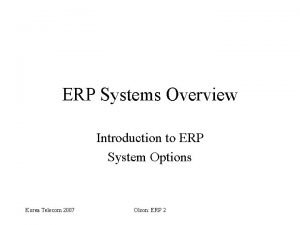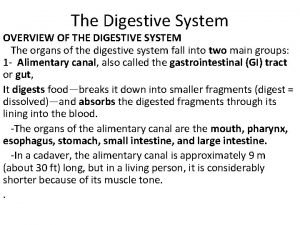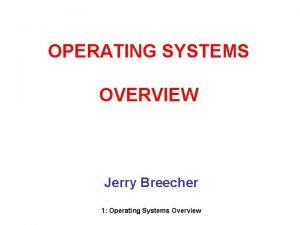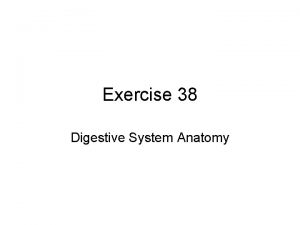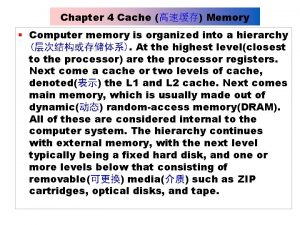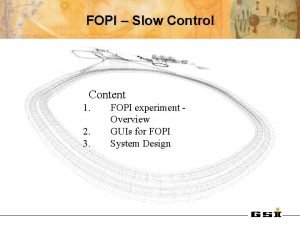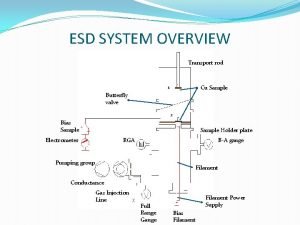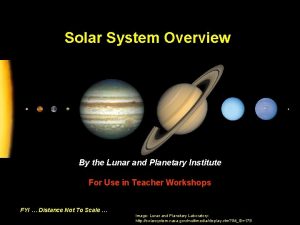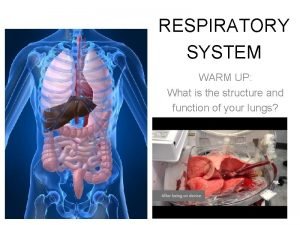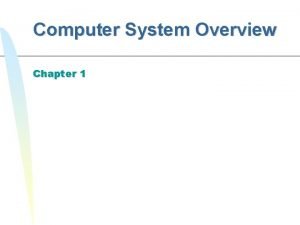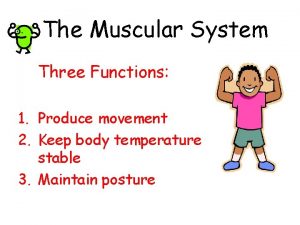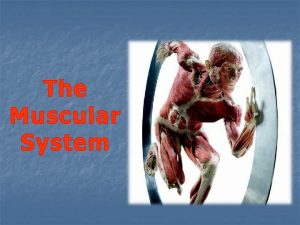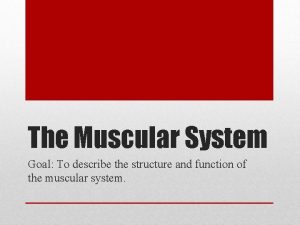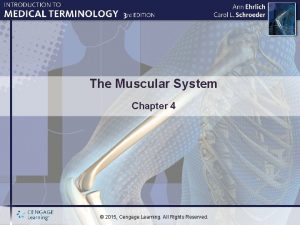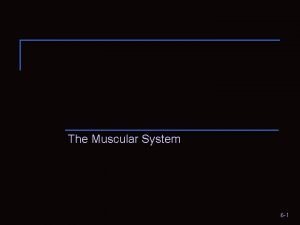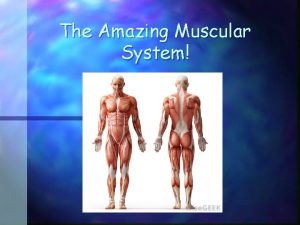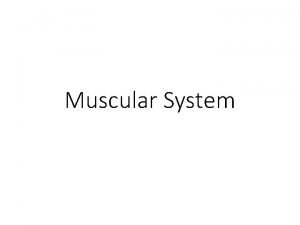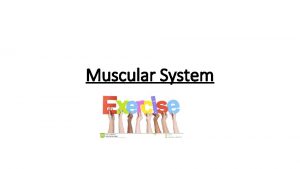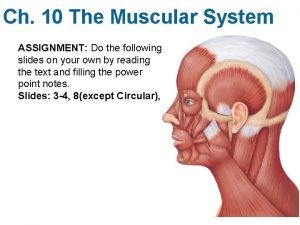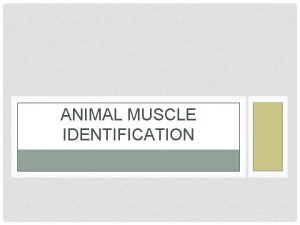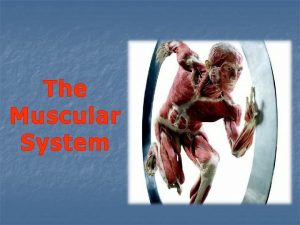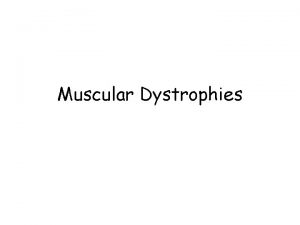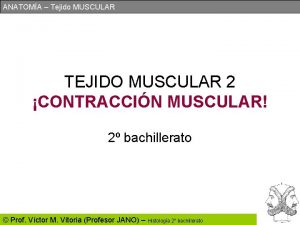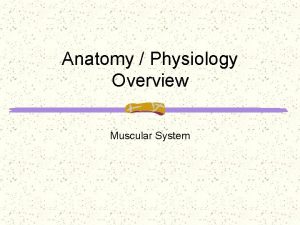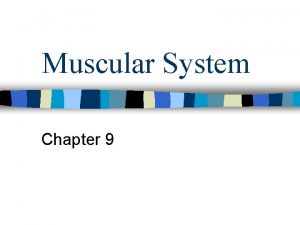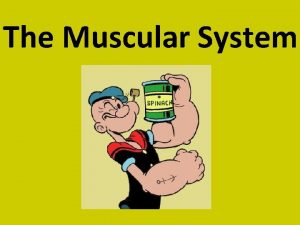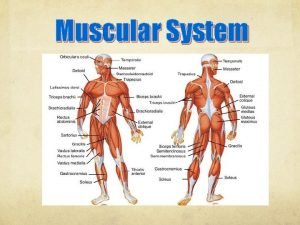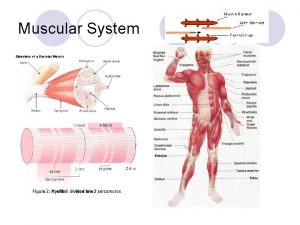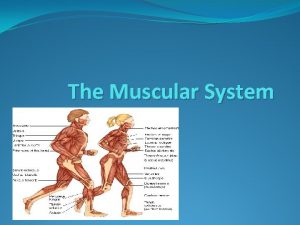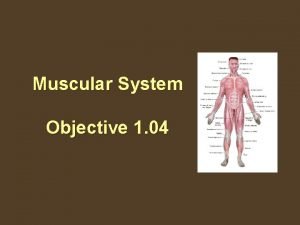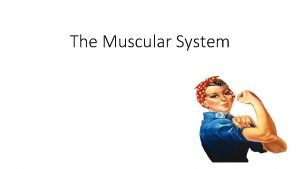The Muscular System Overview of Muscular System Types










































































- Slides: 74

The Muscular System

Overview of Muscular System Types of Muscle Tissue Under voluntary control Skeletal muscles The muscular system Under involuntary control Cardiac muscle Heart wall Smooth muscle Visceral organs Copyright © 2007 Pearson Education, Inc. , publishing as Benjamin Cummings

Overview of Muscular System Skeletal muscles attach to bones directly or indirectly five functions: Produce movement of skeleton Maintain posture and body position Support soft tissues Guard entrances and exits Maintain body temperature Copyright © 2007 Pearson Education, Inc. , publishing as Benjamin Cummings

Anatomy of Skeletal Muscles Gross Anatomy Connective tissue organization Epimysium Fibrous covering of whole muscle Perimysium Fibrous covering of fascicle Endomysium Fibrous Tendons covering of a single cell (a muscle fiber) (or aponeurosis) Copyright © 2007 Pearson Education, Inc. , publishing as Benjamin Cummings

Anatomy of Skeletal Muscles The Organization of a Skeletal Muscle Figure 7 -1

Anatomy of Skeletal Muscles Microanatomy of a Muscle Fiber Sarcolemma Muscle cell membrane Sarcoplasm Muscle cell cytoplasm Sarcoplasmic reticulum (SR) Like smooth ER Transverse tubules (T tubules) Myofibrils (contraction organelle) Sarcomeres Copyright © 2007 Pearson Education, Inc. , publishing as Benjamin Cummings

Anatomy of Skeletal Muscles Sarcomere—Repeating structural unit of the myofibril Components of a sarcomere Myofilaments Thin filaments (mostly actin) Thick filaments (mostly myosin) Z lines at each end Anchor for thin filaments Copyright © 2007 Pearson Education, Inc. , publishing as Benjamin Cummings

Anatomy of Skeletal Muscles The Organization of a Single Muscle Fiber Figure 7 -2(a)

Anatomy of Skeletal Muscles The Organization of a Single Muscle Fiber Figure 7 -2(b)

Anatomy of Skeletal Muscles The Organization of a Single Muscle Fiber PLAY Anatomy of Skeletal Muscles Figure 7 -2(cde)

Anatomy of Skeletal Muscles Changes in the Appearance of a Sarcomere During Contraction of a Skeletal Muscle Fiber Figure 7 -3 (1 of 2)

Anatomy of Skeletal Muscles Changes in the Appearance of a Sarcomere During Contraction of a Skeletal Muscle Fiber Figure 7 -3 (2 of 2)

Control of Muscle Contraction Steps in Neuromuscular Transmission Motor neuron action potential Acetylcholine release and binding Action potential in sarcolemma T tubule action potential Calcium release from SR Copyright © 2007 Pearson Education, Inc. , publishing as Benjamin Cummings

Control of Muscle Contraction The Neuromuscular Junction Synaptic terminal Acetylcholine release Synaptic cleft Motor end plate Acetylcholine receptors Acetylcholine binding Acetylcholinesterase Acetylcholine removal Copyright © 2007 Pearson Education, Inc. , publishing as Benjamin Cummings

Control of Muscle Contraction The Structure and Function of the Neuromuscular Junction Figure 7 -4(a)

Action potential Arrival of an action potential at the synaptic terminal Axon Arriving action potential Synaptic terminal Sarcolemma Vesicles ACh Synaptic cleft Sarcolemma of motor end plate ACh. E molecules ACh receptor site ACh binding at the motor and plate Release of acetylcholine Vesicles in the synaptic terminal fuse with the neuronal membrane and dump their contents into the synaptic cleft. Muscle fiber The binding of ACh to the receptors increases the membrane permeability to sodium ions. Sodium ions then rush into the cell. Appearance of an action potential in the sarcolemma An action potential spreads across the surface of the sarcolemma. While this occurs, ACh. E removes the ACh. Action potential Na+ Na+ Copyright © 2007 Pearson Education, Inc. , publishing as Benjamin Cummings Figure 7 -4(b-c) 5 of 5

Anatomy of Skeletal Muscles The Contraction Process Actin active sites and myosin cross-bridges interact Thin filaments slide past thick filaments Cross-bridges undergo a cycle of movement Attach, pivot, detach, return Troponin-tropomyosin control interaction Prevent interaction at rest Copyright © 2007 Pearson Education, Inc. , publishing as Benjamin Cummings

Resting sarcomere ADP + P Myosin head Troponin Active-site exposure ADP + P Sarcoplasm Actin ADP + P Ca 2+ Tropomyosin Cross-bridge formation Ca 2+ Active site ADP P + Myosin reactivation ADP Ca 2+ P + Ca 2+ ADP P + Cross bridge detachment Pivoting of myosin head ATP ADP + P Ca 2+ ADP P + Copyright © 2007 Pearson Education, Inc. , publishing as Benjamin Cummings Ca 2+ ATP Ca 2+ ADP + P Figure 7 -5 7 of 7

Control of Muscle Contraction Summary of Contraction Process Table 7 -1

Muscle Mechanics • Muscle tension • the pulling force on the tendons • muscle cells generate when contracting • Muscle twitch • A brief contraction-relaxation • response to a single action potential Copyright © 2007 Pearson Education, Inc. , publishing as Benjamin Cummings

Muscle Mechanics The Twitch and Development of Tension Figure 7 -6

Muscle Mechanics The Frequency of Muscle Fiber Stimulation Summation Addition of twitch tension when a stimulus is applied before tension has completely relaxed Incomplete tetanus Tension peaks and falls repeatedly and builds up beyond twitch tension Complete tetanus Tension is steady (no relaxation phase) and largest if stimuli arrive at very high rates Copyright © 2007 Pearson Education, Inc. , publishing as Benjamin Cummings

Muscle Mechanics The Effects of Repeated Stimulations Figure 7 -7

Muscle Mechanics Motor Unit A motor neuron and all the muscle cells it controls Recruitment To increase muscle tension by activating more motor units Small motor units = finer control Motor units are intermixed in the muscle to pull evenly on the tendon Copyright © 2007 Pearson Education, Inc. , publishing as Benjamin Cummings

Muscle Mechanics Motor Units Figure 7 -8

Muscle Mechanics voluntary (intentional) movements involve the sustained, sub-tetanic contractions skeletal units muscle fibers organized into distinct motor force generated can be increased increasing the frequency of action potentials recruiting additional motor units Copyright © 2007 Pearson Education, Inc. , publishing as Benjamin Cummings

Muscle Mechanics • Muscle tone • Tension in a “resting” muscle produced by a low level of spontaneous motor neuron activity. • Distinct from resting tension • produced by passive stretching • Function of muscle tone Stabilizes bones, joints Prevents atrophy (muscle wasting ) Copyright © 2007 Pearson Education, Inc. , publishing as Benjamin Cummings

Muscle Mechanics Types of Contractions Isotonic contraction The tension (load) on a muscle stays constant during a movement iso = same tonic = tension Example: lifting a baby Isometric contraction The length of a muscle stays constant during a “contraction” iso = same metric = length Example: holding a baby at arms length Copyright © 2007 Pearson Education, Inc. , publishing as Benjamin Cummings

Muscle Mechanics Muscle Elongation Muscle contracts actively Muscles can only pull Muscles never push Muscle elongates passively Elastic forces Contraction of opposing muscles Effects of gravity Copyright © 2007 Pearson Education, Inc. , publishing as Benjamin Cummings

Energetics of Muscle Contraction ATP Generation Light activity Aerobic metabolism of fatty acids Storage of glucose as glycogen Moderate activity Breakdown of glycogen to glucose Glycolysis of glucose Peak activity Anerobic breakdown of glucose Production of lactic acid Copyright © 2007 Pearson Education, Inc. , publishing as Benjamin Cummings

Energetics of Muscle Contraction Muscle Metabolism Figure 7 -9(a)

Energetics of Muscle Contraction Muscle Metabolism Figure 7 -9(b)

Energetics of Muscle Contraction Muscle Metabolism Figure 7 -9(c)

Energetics of Muscle Contraction Muscle Fatigue muscle loses ability to contract low p. H (lactic acid buildup) low ATP levels other problems Recovery Period Time after muscle activity that it takes to restore pre-exertion conditions Oxygen Debt Amount of excess oxygen used during the recovery period Copyright © 2007 Pearson Education, Inc. , publishing as Benjamin Cummings

Muscle Performance Two Types of Skeletal Muscle Fibers • Fast fibers • Large diameter • abundant myofibrils • ample glycogen • scant mitochondria • Produce powerful, brief contractions • Slow fibers • • • Smaller diameter rich capillary supply many mitochondria much myoglobin Produce slow, steady contractions Copyright © 2007 Pearson Education, Inc. , publishing as Benjamin Cummings

Muscle Performance Physical Conditioning Anaerobic endurance Time over which a muscle can contract effectively under anerobic conditions Hypertrophy Increase Can in muscle bulk result from anerobic training Aerobic endurance Time over which a muscle can contract supported by mitochondria Copyright © 2007 Pearson Education, Inc. , publishing as Benjamin Cummings

Muscle Performance don’t use = you lose motor units inactive for days or weeks muscle fibers break down their contractile proteins grow smaller and weaker motor units inactive for long periods muscle fibers may be replaced by fibrous tissue Copyright © 2007 Pearson Education, Inc. , publishing as Benjamin Cummings

Cardiac and Smooth Muscle Cardiac Muscle Tissue Small cells Single nucleus/cell Aerobic metabolism Intercalated discs Long contraction time Self-exciting (automaticity) No tetanic contraction Copyright © 2007 Pearson Education, Inc. , publishing as Benjamin Cummings

Cardiac and Smooth Muscle Tissue Nonstriated cells (no sarcomeres) Calcium control of contraction different from striated muscle Wide range of operating lengths Involuntary muscle Under hormonal or local control Pacesetter cells Motor neurons often unneeded Copyright © 2007 Pearson Education, Inc. , publishing as Benjamin Cummings

Cardiac and Smooth Muscle Cardiac Muscle Tissue Figure 7 -10(a)

Cardiac and Smooth Muscle Tissue Figure 7 -10(b)

Cardiac and Smooth Muscle Table 7 -2

Anatomy of the Muscular System An Overview of the Major Skeletal Muscles Figure 7 -11(a)

Anatomy of the Muscular System An Overview of the Major Skeletal Muscles Figure 7 -11(b)

Anatomy of the Muscular System Origin Muscle attachment that remains fixed Insertion Muscle attachment that moves Action What joint movement a muscle produces Copyright © 2007 Pearson Education, Inc. , publishing as Benjamin Cummings

Anatomy of the Muscular System Primary Action Categories Prime mover (agonist) Main muscle in an action Synergist Helper muscle in an action Antagonist Opposed muscle to an action Copyright © 2007 Pearson Education, Inc. , publishing as Benjamin Cummings

Anatomy of the Muscular System Axial musculature— Muscles with origins on the axial skeleton that position and move head, spine, rib cage Appendicular musculature— Muscles that stabilize or move appendicular components Copyright © 2007 Pearson Education, Inc. , publishing as Benjamin Cummings

Anatomy of the Muscular System The Axial Muscles Four groups of axial muscles Head and neck Spine Trunk Pelvic floor Copyright © 2007 Pearson Education, Inc. , publishing as Benjamin Cummings

Anatomy of the Muscular System Muscles of the Head and Neck Figure 7 -12(a)

Anatomy of the Muscular System Muscles of the Head and Neck Figure 7 -12(b)

Anatomy of the Muscular System Muscles of the Head and Neck Figure 7 -12(c)

Muscles of the Anterior Neck Anatomy of the Muscular System Figure 7 -13

Anatomy of the Muscular System Muscles of the Spine Figure 7 -14

Anatomy of the Muscular System Oblique and Rectus Muscles and the Diaphragm Figure 7 -15(a)

Anatomy of the Muscular System Oblique and Rectus Muscles and the Diaphragm Figure 7 -15(b)

Anatomy of the Muscular System Oblique and Rectus Muscles and the Diaphragm Figure 7 -15(c)

Anatomy of the Muscular System Muscles of the Pelvic Floor (Perineum) Sheets of muscle From sacrum and coccyx To pubis and ischium Pelvic organ support Control of material passing through urethra and anus Copyright © 2007 Pearson Education, Inc. , publishing as Benjamin Cummings

Anatomy of the Muscular System Muscles of the Perineum—Female Figure 7 -16(a)

Anatomy of the Muscular System Muscles of the Perineum—Male Figure 7 -16(b)

Anatomy of the Muscular System The Appendicular Muscles Two functionally distinct groups Muscles of the shoulder and upper limbs Muscles of the pelvic girdle and lower limbs Copyright © 2007 Pearson Education, Inc. , publishing as Benjamin Cummings

Anatomy of the Muscular System Muscles of the Shoulder Figure 7 -17(a)

Anatomy of the Muscular System Muscles of the Shoulder Figure 7 -17(b)

Anatomy of the Muscular System Muscles that Move the Arm Figure 7 -18(a)

Anatomy of the Muscular System Muscles that Move the Arm Figure 7 -18(b)

Anatomy of the Muscular System Muscles That Move the Forearm and Wrist Figure 7 -19

Anatomy of the Muscular System Muscle of the Pelvis and Lower Limbs Three functional groups Thigh movement Leg movement Ankle, foot, and toe movement Copyright © 2007 Pearson Education, Inc. , publishing as Benjamin Cummings

Muscles That Move the Thigh Anatomy of the Muscular System Figure 7 -20(a)

Anatomy of the Muscular System Muscles That Move the Thigh Figure 7 -20(b)

Anatomy of the Muscular System Muscles That Move the Leg Figure 7 -21

Anatomy of the Muscular System Muscles That Move the Foot and Toes Figure 7 -22(a)

Anatomy of the Muscular System Muscles That Move the Foot and Toes Figure 7 -22(b)

Anatomy of the Muscular System Muscles That Move the Foot and Toes Figure 7 -22(c)

Anatomy of the Muscular System Muscles That Move the Foot and Toes Figure 7 -22(d)

Aging and the Muscular System Age-Related Reductions Muscle size Muscle elasticity Muscle strength Exercise tolerance Injury recovery ability Copyright © 2007 Pearson Education, Inc. , publishing as Benjamin Cummings
 Plyometrics disadvantages
Plyometrics disadvantages Hát kết hợp bộ gõ cơ thể
Hát kết hợp bộ gõ cơ thể Bổ thể
Bổ thể Tỉ lệ cơ thể trẻ em
Tỉ lệ cơ thể trẻ em Chó sói
Chó sói Chụp phim tư thế worms-breton
Chụp phim tư thế worms-breton Chúa yêu trần thế alleluia
Chúa yêu trần thế alleluia Môn thể thao bắt đầu bằng chữ đua
Môn thể thao bắt đầu bằng chữ đua Thế nào là hệ số cao nhất
Thế nào là hệ số cao nhất Các châu lục và đại dương trên thế giới
Các châu lục và đại dương trên thế giới Công thức tính độ biến thiên đông lượng
Công thức tính độ biến thiên đông lượng Trời xanh đây là của chúng ta thể thơ
Trời xanh đây là của chúng ta thể thơ Cách giải mật thư tọa độ
Cách giải mật thư tọa độ 101012 bằng
101012 bằng độ dài liên kết
độ dài liên kết Các châu lục và đại dương trên thế giới
Các châu lục và đại dương trên thế giới Thơ thất ngôn tứ tuyệt đường luật
Thơ thất ngôn tứ tuyệt đường luật Quá trình desamine hóa có thể tạo ra
Quá trình desamine hóa có thể tạo ra Một số thể thơ truyền thống
Một số thể thơ truyền thống Cái miệng nó xinh thế
Cái miệng nó xinh thế Vẽ hình chiếu vuông góc của vật thể sau
Vẽ hình chiếu vuông góc của vật thể sau Biện pháp chống mỏi cơ
Biện pháp chống mỏi cơ đặc điểm cơ thể của người tối cổ
đặc điểm cơ thể của người tối cổ Ví dụ về giọng cùng tên
Ví dụ về giọng cùng tên Vẽ hình chiếu đứng bằng cạnh của vật thể
Vẽ hình chiếu đứng bằng cạnh của vật thể Tia chieu sa te
Tia chieu sa te Thẻ vin
Thẻ vin đại từ thay thế
đại từ thay thế điện thế nghỉ
điện thế nghỉ Tư thế ngồi viết
Tư thế ngồi viết Diễn thế sinh thái là
Diễn thế sinh thái là Dot
Dot Bảng số nguyên tố
Bảng số nguyên tố Tư thế ngồi viết
Tư thế ngồi viết Lời thề hippocrates
Lời thề hippocrates Thiếu nhi thế giới liên hoan
Thiếu nhi thế giới liên hoan ưu thế lai là gì
ưu thế lai là gì Hổ đẻ mỗi lứa mấy con
Hổ đẻ mỗi lứa mấy con Sự nuôi và dạy con của hổ
Sự nuôi và dạy con của hổ Sơ đồ cơ thể người
Sơ đồ cơ thể người Từ ngữ thể hiện lòng nhân hậu
Từ ngữ thể hiện lòng nhân hậu Thế nào là mạng điện lắp đặt kiểu nổi
Thế nào là mạng điện lắp đặt kiểu nổi Sap erp system overview
Sap erp system overview Database content management system
Database content management system Introduction to computerized accounting
Introduction to computerized accounting Ductus parotideus
Ductus parotideus Crtd in sap
Crtd in sap Operating system overview
Operating system overview Fitness management system
Fitness management system Overview of the digestive system
Overview of the digestive system Set associative mapping in cache memory
Set associative mapping in cache memory Computer memory system overview
Computer memory system overview British school system overview
British school system overview Financial intermediaries
Financial intermediaries British school system overview
British school system overview System design
System design System design overview
System design overview System overview sample
System overview sample Solar system overview
Solar system overview Lung 3 lobes
Lung 3 lobes Computer system overview
Computer system overview What do muscles move
What do muscles move Whats the function of the muscular system
Whats the function of the muscular system Main function of muscular system
Main function of muscular system Chapter 4 the muscular system learning exercises answer key
Chapter 4 the muscular system learning exercises answer key Chapter 6 the muscular system figure 6-9
Chapter 6 the muscular system figure 6-9 Simple muscular system diagram
Simple muscular system diagram What is a root word
What is a root word Muscular system label
Muscular system label Rectus femoris fascicle arrangement
Rectus femoris fascicle arrangement Muscular system head and neck
Muscular system head and neck Brachiocephalicus
Brachiocephalicus Navigating the body muscular system #2
Navigating the body muscular system #2 Whats the function of the muscular system
Whats the function of the muscular system










































